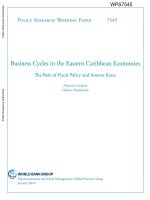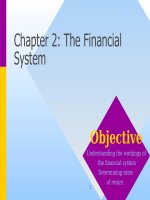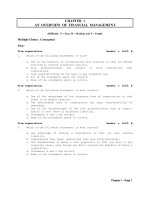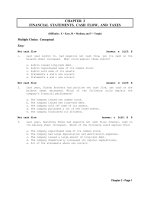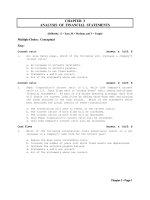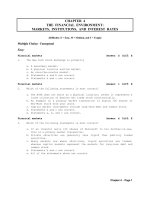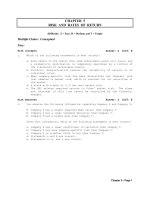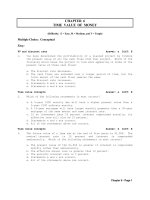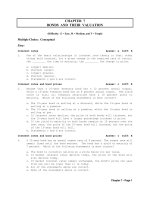Test bank Finance Management chapter 04 the financial environment markets, institutions, and interest rates
Bạn đang xem bản rút gọn của tài liệu. Xem và tải ngay bản đầy đủ của tài liệu tại đây (353.88 KB, 58 trang )
CHAPTER 4
THE FINANCIAL ENVIRONMENT:
MARKETS, INSTITUTIONS, AND INTEREST RATES
(Difficulty: E = Easy, M = Medium, and T = Tough)
Multiple Choice: Conceptual
Easy:
Financial markets
1.
Diff: E
Answer: c
Diff: E
The New York Stock Exchange is primarily
a.
b.
c.
d.
e.
A secondary market.
A physical location auction market.
An over-the-counter market.
Statements a and b are correct.
Statements b and c are correct.
Financial markets
2.
Answer: d
Which of the following statements is most correct?
a. The NYSE does not exist as a physical location; rather it represents a
loose collection of dealers who trade stock electronically.
b. An example of a primary market transaction is buying 100 shares of
Wal-Mart stock from your uncle.
c. Capital market instruments include long-term debt and common stock.
d. Statements b and c are correct.
e. Statements a, b, and c are correct.
Financial markets
3.
Answer: d
Diff: E
Which of the following statements is most correct?
a. If an investor sells 100 shares of Microsoft to his brother-in-law,
this is a primary market transaction.
b. Private securities are generally less liquid than publicly traded
securities.
c. Money markets are where short-term, liquid securities are traded,
whereas capital markets represent the markets for long-term debt and
common stock.
d. Statements b and c are correct.
e. All of the statements above are correct.
Chapter 4 - Page 1
Financial markets
4.
Diff: E
Which of the following is a secondary market transaction?
a.
b.
c.
d.
e.
You sell 200 shares of IBM stock in the open market.
You buy 200 shares of IBM stock from your brother.
IBM issues 2 million shares of new stock to the public.
Statements a and b are correct.
All of the statements above are correct.
Financial markets
5.
Answer: d
Answer: c
Diff: E
Which of the following statements is most correct?
a. Money markets are markets for long-term debt and common stocks.
b. Primary markets are markets where existing securities are traded among
investors.
c. A derivative is a security whose value is derived from the price of
some other “underlying” asset.
d. Statements a and b are correct.
e. Statements b and c are correct.
Financial markets
6.
Answer: c
Diff: E
N
Which of the following statements is most correct?
a. While the distinctions are blurring, investment banks generally
specialize in lending money, whereas commercial banks generally help
companies raise capital from other parties.
b. Money market mutual funds usually invest their money in a welldiversified portfolio of liquid common stocks.
c. The NYSE operates as an auction market, whereas NASDAQ is an example
of a dealer market.
d. Statements b and c are correct.
e. All of the statements above are correct.
Capital market instruments
7.
Diff: E
Which of the following is an example of a capital market instrument?
a.
b.
c.
d.
e.
Commercial paper.
Preferred stock.
U.S. Treasury bills.
Banker’s acceptances.
Money market mutual funds.
Money markets
8.
Answer: b
Money markets are markets for
a.
b.
c.
d.
e.
Foreign currency exchange.
Consumer automobile loans.
Corporate stocks.
Long-term bonds.
Short-term debt securities.
Chapter 4 - Page 2
Answer: e
Diff: E
Financial transactions
9.
Answer: a
Diff: E
Which of the following statements is correct?
a. The New York Stock Exchange is a physical location auction market.
b. Money markets include markets for consumer automobile loans.
c. If an investor sells shares of stock through a broker, then it would
be a primary market transaction.
d. Capital market transactions involve only the purchase and sale of
equity securities.
e. None of the statements above is correct.
Financial transactions
10.
Diff: E
You recently sold 100 shares of Microsoft stock to your brother at a
family reunion.
At the reunion your brother gave you a check for the
stock and you gave your brother the stock certificates.
Which of the
following best describes this transaction?
a.
b.
c.
d.
e.
This is an
This is an
This is an
This is an
Statements
example of a direct transfer of capital.
example of a primary market transaction.
example of an exchange of physical assets.
example of a money-market transaction.
a, b, and d are correct. Statement c is incorrect.
Financial transactions
11.
Answer: a
Answer: e
Diff: E
Which of the following statements is most correct?
a. If you purchase 100 shares of Disney stock from your brother-in-law,
this is an example of a primary market transaction.
b. If Disney issues additional shares of common stock, this is an example
of a secondary market transaction.
c. The NYSE is an example of an over-the-counter market.
d. Statements a and b are correct.
e. None of the statements above is correct.
Financial transactions
12.
Answer: c
You recently sold 200 shares of Disney stock to your brother.
example of:
a.
b.
c.
d.
e.
Diff: E
This is an
A money market transaction.
A primary market transaction.
A secondary market transaction.
A futures market transaction.
Statements a and b are correct.
Chapter 4 - Page 3
Primary market transactions
13.
Answer: e
Diff: E
Which of the following are examples of a primary market transaction?
a. A company issues new common stock.
b. A company issues new bonds.
c. An investor asks his broker to purchase 1,000 shares of Microsoft
common stock.
d. All of the statements above are correct.
e. Statements a and b are correct.
Risk and return
14.
Diff: E
Your uncle would like to limit his interest rate risk and his default
risk, but he would still like to invest in corporate bonds. Which of the
possible bonds listed below best satisfies your uncle’s criteria?
a.
b.
c.
d.
e.
AAA
BBB
BBB
AAA
BBB
bond with
perpetual
bond with
bond with
bond with
Yield curve
15.
Answer: d
10 years to maturity.
bond.
10 years to maturity.
5 years to maturity.
5 years to maturity.
Answer: a
Diff: E
Assume that inflation is expected to steadily decline in the years ahead,
but that the real risk-free rate, k*, is expected to remain constant.
Which of the following statements is most correct?
a. If the expectations theory holds, the Treasury yield curve must be
downward sloping.
b. If the expectations theory holds, the yield curve for corporate
securities must be downward sloping.
c. If there is a positive maturity risk premium, the Treasury yield curve
must be upward sloping.
d. Statements b and c are correct.
e. All of the statements above are correct.
Yield curve
16.
Answer: a
Diff: E
If the yield curve is downward sloping, what is the yield to maturity on
a 10-year Treasury coupon bond, relative to that on a 1-year T-bond?
a. The yield on the 10-year bond is less than the yield on a 1-year bond.
b. The yield on a 10-year bond will always be higher than the yield on a
1-year bond because of maturity risk premiums.
c. It is impossible to tell without knowing the coupon rates of the
bonds.
d. The yields on the two bonds are equal.
e. It is impossible to tell without knowing the relative risks of the two
bonds.
Chapter 4 - Page 4
Yield curve
17.
Answer: c
Diff: E
Which of the following statements is most correct?
a. Downward sloping yield curves are inconsistent with the expectations
theory.
b. The shape of the yield curve depends only on expectations about future
inflation.
c. If the expectations theory is correct, a downward sloping yield curve
indicates that interest rates are expected to decline in the future.
d. Statements a and c are correct.
e. None of the statements above is correct.
Yield curve
18.
The real risk-free rate of interest, k*,
at 3 percent. Inflation is expected to
then 2 percent a year thereafter.
The
Given this information, which of the
correct?
Answer: e
Diff: E
is expected to remain
be 3 percent for next
maturity risk premium
following statements
constant
year and
is zero.
is most
a. The yield curve for U.S. Treasury securities is downward sloping.
b. A 5-year corporate bond has a higher yield than a 5-year Treasury
security.
c. A 5-year corporate bond has a higher yield than a 7-year Treasury
security.
d. Statements a and b are correct.
e. All of the statements above are correct.
Yield curve
19.
Answer: c
Diff: E
Which of the following statements is most correct?
a. If the maturity risk premium (MRP) is greater than zero, the yield
curve must be upward sloping.
b. If the maturity risk premium (MRP) equals zero, the yield curve must
be flat.
c. If interest rates are expected to increase in the future and the
maturity risk premium (MRP) is greater than zero, the yield curve will
be upward sloping.
d. If the expectations theory holds, the yield curve will never be
downward sloping.
e. All of the statements above are correct.
Chapter 4 - Page 5
Yield curve
20.
Answer: e
Diff: E
For the foreseeable future, the real risk-free rate of interest, k*, is
expected to remain at 3 percent.
Inflation is expected to steadily
increase over time. The maturity risk premium equals 0.1(t - 1)%, where
t represents the bond’s maturity.
On the basis of this information,
which of the following statements is most correct?
a. The yield on 10-year Treasury securities must exceed the yield on
2-year Treasury securities.
b. The yield on 10-year Treasury securities must exceed the yield on
5-year corporate bonds.
c. The yield on 10-year corporate bonds must exceed the yield on 8-year
Treasury securities.
d. Statements a and b are correct.
e. Statements a and c are correct.
Interest rates
21.
Answer: c
Diff: E
Which of the following statements is most correct?
a. If companies have fewer productive opportunities, interest rates are
likely to increase.
b. If individuals increase their savings rate, interest rates are likely
to increase.
c. If expected inflation increases, interest rates are likely to increase.
d. All of the statements above are correct.
e. Statements a and c are correct.
Interest rates
22.
Answer: b
Diff: E
Which of the following is likely to increase the level of interest rates
in the economy?
a. Households start saving a larger percentage of their income.
b. Corporations step up their plans for expansion and increase their
demand for capital.
c. The level of inflation is expected to decline.
d. All of the statements above are correct.
e. None of the statements above is correct.
Interest rates
23.
Answer: d
Diff: E
N
Which of the following factors are likely to lead to an increase in
nominal interest rates?
a. Households increase their savings rate.
b. Companies see an increase in their production opportunities that
leads to an increase in the demand for funds.
c. There is an increase in expected inflation.
d. Statements b and c are correct.
e. All of the statements above are correct.
Chapter 4 - Page 6
Interest rates
24.
Answer: b
Diff: E
N
Which of the following statements is most correct?
a. The yield on a 3-year Treasury bond cannot exceed the yield on a 10year Treasury bond.
b. The yield on a 2-year corporate bond will always exceed the yield on
a 2-year Treasury bond.
c. The yield on a 3-year corporate bond will always exceed the yield on
a 2-year corporate bond.
d. Statements b and c are correct.
e. All of the statements above are correct.
Cost of money
25.
Diff: E
N
Which of the following is likely to lead to an increase in the cost of
funds?
a. Companies’
the demand
b. Households
c. Households
banks.
d. Statements
e. Statements
Expectations theory
26.
Answer: c
production opportunities decline, leading to a decline in
for funds.
save a larger portion of their income.
increase the amount of money they borrow from their local
a and b are correct.
a and c are correct.
Answer: c
Diff: E
Assume that the expectations theory describes the term structure
interest rates. Which of the following statements is most correct?
of
a. In equilibrium long-term rates equal short term rates.
b. An upward-sloping yield curve implies that interest rates are expected
to decline in the years ahead.
c. The maturity risk premium is zero.
d. Statements a and b are correct.
e. None of the statements above is correct.
Expectations theory
27.
Answer: a
Diff: E
The real risk-free rate, k*, is expected to remain constant at 3 percent
per year. Inflation is expected to be 2 percent per year forever. Assume
that the expectations theory holds; that is, there is no maturity risk
premium. Treasury securities do not require any default risk or liquidity
premiums. Which of the following statements is most correct?
a. The Treasury yield curve is flat and all Treasury securities yield
5 percent.
b. The Treasury yield curve is upward sloping for the first 10 years, and
then downward sloping.
c. The yield curve for corporate bonds must be flat, but corporate bonds
will yield more than 5 percent.
d. Statements a and c are correct.
e. Statements b and c are correct.
Chapter 4 - Page 7
Expectations theory
28.
Diff: E
One-year interest rates are 6 percent. The market expects 1-year rates to
be 7 percent one year from now. The market also expects 1-year rates will
be 8 percent two years from now. Assume that the expectations theory
holds regarding the term structure (that is, the maturity risk premium
equals zero). Which of the following statements is most correct?
a.
b.
c.
d.
e.
The yield curve is downward sloping.
Today’s 2-year interest rate is 8 percent.
Today’s 2-year interest rate is 7 percent.
Today’s 3-year interest rate is 7 percent.
Today’s 3-year interest rate is 9 percent.
Expectations theory
29.
Answer: d
Answer: e
Diff: E
The real risk-free rate of interest is expected to remain constant at
3 percent for the foreseeable future. However, inflation is expected to
steadily increase over the next 20 years, so the Treasury yield curve is
upward sloping. Assume that the expectations theory holds. You are
considering two corporate bonds: a 5-year corporate bond and a 10-year
corporate bond, each of which has the same default risk and liquidity
risk. Given this information, which of the following statements is most
correct?
a. Since the expectations theory holds, this implies that 10-year
Treasury bonds must have the same yield as 5-year Treasury bonds.
b. Since the expectations theory holds, this implies that the 10-year
corporate bonds must have the same yield as the 5-year corporate
bonds.
c. Since the expectations theory holds, this implies that the 10-year
corporate bonds must have the same yield as 10-year Treasury bonds.
d. The 10-year Treasury bond must have a higher yield than the 5-year
corporate bond.
e. The 10-year corporate bond must have a higher yield than the 5-year
corporate bond.
Medium:
Financial transactions
30.
Answer: d
Diff: M
If the Federal Reserve sells $50 billion of short-term U.S. Treasury
securities to the public, other things held constant, what will this tend
to do to short-term security prices and interest rates?
a.
b.
c.
d.
e.
Prices and interest rates will both rise.
Prices will rise and interest rates will decline.
Prices and interest rates will both decline.
Prices will decline and interest rates will rise.
There will be no changes in either prices or interest rates.
Chapter 4 - Page 8
Financial transactions
31.
Answer: d
Diff: M
Which of the following statements is most correct?
a. The distinguishing feature between spot markets versus futures markets
transactions is the maturity of the investments. That is, spot market
transactions involve securities that have maturities of less than one
year whereas futures markets transactions involve securities with
maturities greater than one year.
b. Capital market transactions only include preferred stock and common
stock transactions.
c. If General Electric were to issue new stock this year it would be
considered a secondary market transaction since the company already
has stock outstanding.
d. Both dealers in Nasdaq and “specialists” in the NYSE hold inventories
of stocks.
e. Statements a and d are correct.
Interest rates
32.
Answer: b
Diff: M
Assume interest rates on long-term government and corporate bonds were as
follows:
T-bond = 7.72%
AAA
= 8.72%
A
= 9.64%
BBB = 10.18%
The differences in rates among these issues were caused primarily by
a.
b.
c.
d.
e.
Tax effects.
Default risk differences.
Maturity risk differences.
Inflation differences.
Statements b and d are correct.
Interest rates
33.
Answer: b
Diff: M
Which of the following statements is most correct?
a. The yield on a 3-year Treasury bond cannot exceed the yield on a 10year Treasury bond.
b. The expectations theory states that the maturity risk premium for
long-term bonds is zero and that differences in interest rates across
different maturities are driven by expectations about future interest
rates.
c. Most evidence suggests that the maturity risk premium is zero.
d. Statements b and c are correct.
e. None of the statements above is correct.
Chapter 4 - Page 9
Interest rates
34.
Answer: a
Diff: M
Which of the following statements is most correct?
a. The yield on a 2-year corporate bond will always exceed the yield on a
2-year Treasury bond.
b. The yield on a 3-year corporate bond will always exceed the yield on a
2-year corporate bond.
c. The yield on a 3-year Treasury bond will always exceed the yield on a
2-year Treasury bond.
d. All of the statements above are correct.
e. Statements a and c are correct.
Term structure theories
35.
Answer: b
Diff: M
Which of the following statements is most correct?
a. The maturity premiums embedded in the interest rates on U.S. Treasury
securities are due primarily to the fact that the probability of
default is higher on long-term bonds than on short-term bonds.
b. Reinvestment rate risk is lower, other things held constant, on longterm than on short-term bonds.
c. The expectations theory of the term structure of interest rates states
that borrowers generally prefer to borrow on a long-term basis while
savers generally prefer to lend on a short-term basis, and that as a
result, the yield curve is normally upward sloping.
d. If the maturity risk premium were zero and interest rates were
expected to decrease in the future, then the yield curve for U.S.
Treasury securities would, other things held constant, have an upward
slope.
e. None of the statements above is correct.
Expectations theory
36.
Answer: e
Diff: M
If the expectations theory of the term structure is correct, which of the
following statements is most correct?
a. An upward sloping yield curve implies that interest rates are expected
to be lower in the future.
b. If 1-year Treasury bills have a yield to maturity of 7 percent, and
2-year Treasury bills have a yield to maturity of 8 percent, this
implies the market believes that 1-year rates will be 7.5 percent one
year from now.
c. The yield on 5-year corporate bonds should always exceed the yield on
3-year Treasury securities.
d. Statements a and c are correct.
e. None of the statements above is correct.
Chapter 4 - Page 10
Expectations theory
37.
Answer: a
Diff: M
Assume that the expectations theory holds.
Which of the following
statements about Treasury bill rates is most correct? (2-year rates apply
to bonds that will mature in two years, 3-year rates apply to bonds that
will mature in 3 years, and so on).
a. If 2-year rates exceed 1-year rates, then the market expects interest
rates to rise.
b. If 2-year rates are 7 percent, and 3-year rates are 7 percent, then
5-year rates must also be 7 percent.
c. If 1-year rates are 6 percent and 2-year rates are 7 percent, then the
market expects 1-year rates to be 6.5 percent in one year.
d. Statements a and c are correct.
e. Statements b and c are correct.
Expectations theory
38.
Answer: c
Diff: M
Which of the following statements is most correct?
a. The expectations theory of the term structure implies that long-term
interest rates should always equal short-term interest rates.
b. If the expectations theory of the term structure is correct, an upward
sloping yield curve implies a positive maturity risk premium (MRP).
c. If the expectations theory of the term structure is correct, an upward
sloping yield curve implies that market participants believe that
interest rates are going to be higher in the future than they are
today.
d. Statements a and b are correct.
e. Statements b and c are correct.
Expectations theory
39.
Answer: e
Diff: M
Which of the following statements is most correct, assuming that the
expectations theory is correct?
a. If the yield curve is upward sloping, the yield on a 2-year corporate
bond must be less than the yield on a 5-year Treasury bond.
b. If the yield curve is upward sloping, the yield on a 2-year Treasury
bond must be less than the yield on a 5-year corporate bond.
c. If the yield curve is downward sloping, the yield on a 10-year
Treasury bond must be less than the yield on an 8-year corporate bond.
d. All of the statements above are correct.
e. Statements b and c are correct.
Chapter 4 - Page 11
Expectations theory
40.
Answer: c
Diff: M
The interest rate on 1-year Treasury securities is 5 percent. The interest
rate on 2-year Treasury securities is 6 percent. The expectations theory is
assumed to be correct. Which of the following statements is most correct?
a. The maturity risk premium is positive.
b. The market expects that 1-year rates will be 5.5 percent one year from
now.
c. The market expects that 1-year rates will be 7 percent one year from
now.
d. The yield curve is downward sloping.
e. None of the statements above is correct.
Expectations theory
41.
Assume that the expectations
statements is most correct?
Answer: d
theory
holds.
Which
of
the
Diff: M
following
a. The yield curve for both Treasury securities and corporate securities
will be flat.
b. The yield curve for Treasury securities is flat, but the yield curve
for corporate securities is likely to be upward sloping.
c. The yield curve for Treasury securities cannot be downward sloping.
d. The maturity risk premium is zero.
e. If 2-year rates yield more than 1-year rates, investors should not
purchase 1-year bonds, and should instead purchase 2-year bonds.
Yield curve
42.
Diff: M
Assume that the current yield curve is upward sloping, or normal.
implies that
a.
b.
c.
d.
e.
This
Short-term interest rates are more volatile than long-term rates.
Inflation is expected to subside in the future.
The economy is at the peak of a business cycle.
Long-term bonds are a better buy than short-term bonds.
None of the statements above is necessarily implied by the yield curve
given.
Yield curve
43.
Answer: e
Answer: e
Diff: M
Which of the following is most correct?
a. If the expectations theory is correct (that is, the maturity risk
premium is zero), then an upward-sloping yield curve means that the
market believes that interest rates will rise in the future.
b. A 5-year corporate bond may have a yield less than a 10-year Treasury
bond.
c. The yield curve for corporate bonds may be upward sloping even if the
Treasury yield curve is flat.
d. Statements b and c are correct.
e. All of the statements above are correct.
Chapter 4 - Page 12
Yield curve
44.
Answer: a
Diff: M
Which of the following is most correct?
a. If the expectations theory is correct, we could see inverted yield
curves.
b. If a yield curve is inverted, short-term bonds have lower yields than
long-term bonds.
c. A positive maturity risk premium increases the likelihood that a yield
curve will be inverted.
d. Statements b and c are correct.
e. None of the statements above is correct.
Yield curve
45.
Answer: e
Diff: M
Which of the following statements is most correct?
a. If the maturity risk premium is zero, the yield curve must be flat.
b. A 10-year corporate bond must have a higher yield than a 5-year
Treasury bond.
c. A 10-year Treasury bond must have a higher yield than a 5-year
Treasury bond.
d. If the Treasury yield curve is downward sloping, the yield curve for
corporate bonds must also be downward sloping.
e. None of the statements above is correct.
Yield curve
46.
Answer: c
Diff: M
A bond trader observes the following information:
The Treasury yield curve is downward sloping.
There is a positive maturity risk premium.
There is no liquidity premium.
On the basis of this information, which of the following statements is
most correct?
a. A 10-year corporate bond must have a higher yield than a 5-year
Treasury bond.
b. A 10-year Treasury bond must have a higher yield than a 10-year
corporate bond.
c. A 5-year corporate bond must have a higher yield than a 10-year
Treasury bond.
d. Statements a and c are correct.
e. All of the statements above are correct.
Chapter 4 - Page 13
Yield curve
47.
Answer: d
Diff: M
N
The real risk-free rate is expected to remain constant over time.
Inflation is expected to be 2 percent a year for the next two years,
after which time it is expected to average 4 percent a year. There is a
positive maturity risk premium on bonds that have a maturity greater than
1 year. Which of the following statements is most correct?
a. The yield on a 5-year government bond must exceed that of a 2-year
government bond.
b. The yield on a 5-year corporate bond must exceed that of a 2-year
government bond.
c. The yield on a 7-year government bond must exceed that of a 5-year
corporate bond.
d. Statements a and b are correct.
e. All of the statements above are correct.
Yield curve
48.
Answer: d
Diff: M
N
Inflation is expected to increase steadily over the next 10 years. There
is also a positive maturity risk premium.
The real risk-free rate of
interest is expected to remain constant. Which of the following statements
is most correct? (Hint: Remember that the default risk premium and the
liquidity premium are zero for Treasury securities: DRP = LP = 0.)
a. The yield on 10-year Treasury securities must exceed the yield on
7-year Treasury securities.
b. The yield on 10-year corporate bonds must exceed the yield on 10-year
Treasury securities.
c. The yield on 7-year corporate bonds must exceed the yield on 10-year
Treasury securities.
d. Statements a and b are correct.
e. All of the statements above are correct.
Corporate yield curve
49.
Answer: d
Diff: M
Churchill Corporation just issued bonds that will mature in 10 years.
George Corporation just issued bonds that will mature in 12 years. Both
bonds are standard coupon bonds that cannot be retired early.
The two
bonds are equally liquid.
Which of the following statements is most
correct?
a. If the yield curve for Treasury securities is flat, Churchill’s bond
will have the same yield as George’s bonds.
b. If the yield curve for Treasury securities is upward sloping, George’s
bonds will have a higher yield than Churchill’s bonds.
c. If the two bonds have the same level of default risk, their yields
will also be the same.
d. If the Treasury yield curve is upward sloping and Churchill has less
default risk than George, then Churchill’s bonds will have a lower
yield.
e. If the Treasury yield curve is downward sloping, George’s bonds will
have a lower yield.
Chapter 4 - Page 14
Multiple Choice: Problems
Easy:
Expected interest rates
50.
Answer: d
Diff: E
N
The real risk-free rate of interest is 3 percent. Inflation is expected
to be 4 percent this coming year, jump to 5 percent next year, and
increase to 6 percent the year after (Year 3).
According to the
expectations theory, what should be the interest rate on 3-year, riskfree securities today?
a. 18%
b. 12%
c. 6%
d. 8%
e. 10%
Expected interest rates
51.
Diff: E
One-year government bonds yield 6 percent and 2-year government bonds
yield 5.5 percent. Assume that the expectations theory holds. What does
the market believe the rate on 1-year government bonds will be one year
from today?
a.
b.
c.
d.
e.
5.00%
5.50%
5.75%
6.00%
7.00%
Expected interest rates
52.
Answer: a
Answer: a
Diff: E
Assume that the expectations theory holds, and that liquidity and
maturity risk premiums are zero.
If the annual rate of interest on a
2-year Treasury bond is 10.5 percent and the rate on a 1-year Treasury
bond is 12 percent, what rate of interest should you expect on a 1-year
Treasury bond one year from now?
a. 9.0%
b. 9.5%
c. 10.0%
d. 10.5%
e. 11.0%
Chapter 4 - Page 15
Expected interest rates
53.
Diff: E
One-year Treasury bills yield 6 percent, while Treasury notes with
2-year maturities yield 6.7 percent.
If the expectations theory holds
(that is, the maturity risk premium is zero), what is the market’s
forecast of what 1-year T-bills will be yielding one year from now?
a.
b.
c.
d.
e.
6.7%
7.4%
7.8%
8.0%
8.2%
Expected interest rates
54.
Answer: b
Answer: b
Diff: E
Two-year Treasury securities yield 6.7 percent, while 1-year Treasury
securities yield 6.3 percent.
Assume that the maturity risk premium
(MRP) equals zero. What does the market anticipate will be the yield on
1-year Treasury securities one year from now?
a. 6.7%
b. 7.1%
c. 13.0%
d. 6.5%
e. 10.2%
Expected interest rates
55.
Diff: E
One-year Treasury securities yield 5 percent, 2-year Treasury securities
yield 5.5 percent, and 3-year Treasury securities yield 6 percent. Assume
that the expectations theory holds. What does the market expect will be
the yield on 1-year Treasury securities two years from now?
a.
b.
c.
d.
e.
6.0%
6.5%
7.0%
7.5%
8.0%
Expected interest rates
56.
Answer: c
Answer: c
Diff: E
N
The real risk-free rate of interest, k*, is 4 percent, and it is expected
to remain constant over time.
Inflation is expected to be
2 percent per year for the next three years, after which time inflation
is expected to remain at a constant rate of 5 percent per year.
The
maturity risk premium is equal to 0.1(t - 1)%, where t = the bond’s
maturity. What is the yield on a 10-year Treasury bond?
a.
b.
c.
d.
e.
8.1%
8.9%
9.0%
9.1%
9.9%
Chapter 4 - Page 16
Expected interest rates
57.
Answer: d
Diff: E
N
You observe the following yield curve for Treasury securities:
Maturity
1 year
2 years
3 years
4 years
5 years
Yield
5.5%
5.8
6.0
6.3
6.5
Assume that the pure expectations hypothesis holds. What does the market
expect will be the yield on 4-year securities, 1 year from today?
a.
b.
c.
d.
e.
6.00%
6.30%
6.40%
6.75%
7.30%
Inflation rate
58.
Diff: E
Given the following data, find the expected rate of inflation during the
next year.
k* = real risk-free rate = 3%.
Maturity risk premium on 10-year T-bonds = 2%. It is zero on 1-year
bonds, and a linear relationship exists.
Default risk premium on 10-year, A-rated bonds = 1.5%.
Liquidity premium = 0%.
Going interest rate on 1-year T-bonds = 8.5%.
a.
b.
c.
d.
e.
3.5%
4.5%
5.5%
6.5%
7.5%
Inflation rate
59.
Answer: c
Answer: d
Diff: E
Suppose that the annual expected rates of inflation over each of the next
five years are 5 percent, 6 percent, 9 percent, 13 percent, and 12
percent, respectively. What is the average expected inflation rate over
the 5-year period?
a. 6%
b. 7%
c. 8%
d. 9%
e. 10%
Chapter 4 - Page 17
Default risk premium
60.
Answer: b
Diff: E
N
The real risk-free rate, k*, is 3 percent.
Inflation is expected to
average 2 percent a year for the next three years, after which time
inflation is expected to average 3.5 percent a year. Assume that there
is no maturity risk premium. A 7-year corporate bond has a yield of 7.6
percent. Assume that the liquidity premium on the corporate bond is 0.4
percent. What is the default risk premium on the corporate bond?
a.
b.
c.
d.
e.
0.70%
1.34%
1.45%
2.01%
2.20%
Medium:
Expected interest rates
61.
Answer: c
Diff: M
You are given the following data:
k* = real risk-free rate = 4%.
Constant inflation premium = 7%.
Maturity risk premium = 1%.
Default risk premium for AAA bonds = 3%.
Liquidity premium for long-term T-bonds = 2%.
Assume that a highly liquid market does not exist for long-term T-bonds,
and the expected rate of inflation is a constant.
Given these
conditions, the nominal risk-free rate for T-bills is
, and the rate
on long-term Treasury bonds is
.
a. 4%; 14%
b. 4%; 15%
c. 11%; 14%
d. 11%; 15%
e. 11%; 17%
Expected interest rates
62.
Answer: b
Diff: M
Drongo Corporation’s 4-year bonds currently yield 7.4 percent. The real
risk-free rate of interest, k*, is 2.7 percent and is assumed to be
constant. The maturity risk premium (MRP) is estimated to be 0.1%(t - 1),
where t is equal to the time to maturity. The default risk and liquidity
premiums for this company’s bonds total 0.9 percent and are believed to be
the same for all bonds issued by this company. If the average inflation
rate is expected to be 5 percent for years 5, 6, and 7, what is the yield
on a 7-year bond for Drongo Corporation?
a.
b.
c.
d.
e.
8.70%
8.34%
7.40%
9.20%
8.54%
Chapter 4 - Page 18
Expected interest rates
63.
8.73%
8.94%
8.65%
7.98%
9.24%
Expected interest rates
Answer: b
Diff: M
The real risk-free rate of interest, k*, is 3 percent.
Inflation is
expected to be 4 percent this year, 5 percent next year, and 3 percent
per year thereafter. The maturity risk premium equals 0.1%(t - 1), where
t equals the bond’s maturity. That is, a 5-year bond has a maturity risk
premium of 0.4 percent or 0.004.
A 5-year corporate bond yields 8
percent. What is the yield on a 10-year corporate bond that has the same
default risk and liquidity premiums as the 5-year corporate bond?
a.
b.
c.
d.
e.
7.2%
8.2%
8.0%
6.8%
8.4%
Expected interest rates
65.
Diff: M
The real risk-free rate is expected to remain constant at 3 percent.
Inflation is expected to be 2 percent a year for the next 3 years, and then
4 percent a year thereafter. The maturity risk premium is 0.1%(t - 1),
where t equals the maturity of the bond. (The maturity risk premium on a
5-year bond is 0.4 percent.) A 5-year corporate bond has a yield of 8.4
percent. What is the yield on a 7-year corporate bond that has the same
default risk and liquidity premiums as the 5-year corporate bond?
a.
b.
c.
d.
e.
64.
Answer: b
Answer: d
Diff: M
The real risk-free rate of interest, k*, equals 2 percent. Inflation is
expected to be 2 percent per year over the next five years and then
3 percent per year thereafter.
The maturity risk premium (MRP) equals
0.05%(t - 1), where t = the maturity of the bond. A 10-year corporate
bond has a yield of 7.8 percent. A 12-year corporate bond has the same
default risk and liquidity premiums as the 10-year corporate bond. What
is the yield on the 12-year bond?
a.
b.
c.
d.
e.
7.48%
7.90%
8.50%
7.98%
8.30%
Chapter 4 - Page 19
Expected interest rates
66.
Diff: M
Assume that k* = 2.0%; the maturity risk premium is found as MRP = 0.1%(t - 1),
where t = years to maturity; the default risk premium for corporate bonds
is found as DRP = 0.05%(t - 1); the liquidity premium is 1 percent for
corporate bonds only; and inflation is expected to be 3 percent, 4 percent,
and 5 percent during the next three years and then 6 percent thereafter.
What is the difference in interest rates between 10-year corporate and
Treasury bonds?
a.
b.
c.
d.
e.
0.45%
1.45%
2.20%
2.75%
3.25%
Expected interest rates
67.
Answer: b
Answer: a
Diff: M
Three-year Treasury securities currently yield 6 percent, while 4-year
Treasury securities currently yield 6.5 percent.
Assume that the
expectations theory holds. What does the market believe the rate will be
on 1-year Treasury securities three years from now?
a. 8.0%
b. 8.5%
c. 9.0%
d. 9.5%
e. 10.0%
Expected interest rates
68.
Answer: d
Diff: M
One-year Treasury securities yield 6.9 percent, while 2-year Treasury
securities yield 7.2 percent.
If the expectations theory is correct
(that is, the maturity risk premium is zero) what does the market
anticipate will be the yield on 1-year Treasury securities one year from
now?
a.
b.
c.
d.
e.
6.0%
6.7%
7.2%
7.5%
8.0%
Chapter 4 - Page 20
Expected interest rates
69.
You observe
maturities:
the
Answer: d
following
Maturity
1 year
3 years
6 years
9 years
12 years
15 years
yields
on
Treasury
securities
of
Diff: M
various
Yield
6.0%
6.4
6.5
6.8
7.0
7.2
Using the expectations theory, forecast the interest rate on 9-year
Treasuries, six years from now. (That is, what will be the yield on
9-year Treasuries, issued in 6 years’ time?)
a.
b.
c.
d.
e.
6.50%
6.65%
6.80%
7.67%
8.00%
Expected interest rates
70.
Answer: d
Diff: M
You observe the following yield curve for Treasury securities:
Maturity
1 year
2 years
3 years
4 years
5 years
Yield
6.2%
6.4
6.7
6.9
7.1
Assume that the expectations theory is correct. What does the market
expect the interest rate on 3-year securities to be 1 year from now?
a.
b.
c.
d.
e.
6.67%
6.70%
6.90%
7.13%
7.50%
Chapter 4 - Page 21
Expected interest rates
71.
Answer: d
Diff: M
You observe the following yield curve for Treasury securities:
Maturity
1 year
2 years
3 years
4 years
5 years
Yield
4.6%
4.8
4.9
4.8
5.2
Assume that the expectations theory holds. What does the market expect
the interest rate on 1-year securities to be four years from today?
a. 4.8%
b. 5.2%
c. 5.6%
d. 6.8%
e. 35.4%
Expected interest rates
72.
Diff: M
Currently, 3-year Treasury securities yield 5.4 percent, 7-year Treasury
securities yield 5.8 percent, and 10-year Treasury securities yield 6.2
percent. If the expectations theory is correct, what does the market
expect will be the yield on 3-year Treasury securities seven years from
today?
a.
b.
c.
d.
e.
6.54%
7.13%
5.80%
4.58%
5.68%
Expected interest rates
73.
Answer: b
Answer: d
Diff: M
Three-year treasury securities yield 5 percent, 5-year treasury
securities yield 6 percent, and 8-year treasury securities yield
7 percent. If the expectations theory is correct, what is the expected
yield on 5-year Treasury securities three years from now?
a.
b.
c.
d.
e.
5.0%
7.0%
6.7%
8.2%
6.0%
Chapter 4 - Page 22
Expected interest rates
74.
In the market
securities:
Answer: c
today,
you
Maturity
3 years
5 years
8 years
observe
the
following
yields
on
Diff: M
Treasury
Yield
6.2%
5.9
5.7
Assume that the expectations theory holds. What does the market expect
the yield on 3-year Treasury securities to be five years from today?
a.
b.
c.
d.
e.
5.50%
6.01%
5.37%
5.70%
9.00%
Expected interest rates
75.
Answer: e
Diff: M
You observe the following yield curve for Treasury securities:
Maturity
1 year
2 years
5 years
7 years
9 years
Yield
5.6%
5.8
6.2
6.6
6.8
Assuming that the expectations theory holds, what does the market expect
the yield on 2-year Treasury securities to be five years from today?
a.
b.
c.
d.
e.
5.80%
6.20%
6.60%
6.92%
7.60%
Chapter 4 - Page 23
Expected interest rates
76.
Answer: b
Diff: M
You observe the following term structure for Treasury securities:
Maturity
1 year
2 years
3 years
4 years
5 years
Yield
5.1%
5.4
5.6
5.7
6.0
Assume that the expectations theory holds. What does the market expect
will be the yield on 2-year Treasury securities three years from today?
a.
b.
c.
d.
e.
5.4%
6.6%
6.8%
7.6%
5.8%
Expected interest rates
77.
Answer: d
Diff: M
A fixed-income analyst has made the following assessments:
The real risk-free rate is expected to remain at 2.5 percent for the
next 10 years.
Inflation is expected to be 3 percent this year, 4 percent next year,
and 5 percent a year thereafter.
The maturity risk premium is 0.1%(t - 1), where t = the maturity of
the bond (in years).
A 5-year corporate bond currently yields 8.5 percent. What will be the
yield on the bond, one year from now, if the above assessments are
correct, and the bond’s default premium and liquidity premium remain
unchanged?
a.
b.
c.
d.
e.
7.30%
8.40%
8.50%
8.75%
8.85%
Chapter 4 - Page 24
Expected interest rates
78.
8.10%
8.27%
8.45%
8.53%
8.68%
Expected interest rates
Answer: c
Diff: M
The real risk-free rate of interest is 2 percent.
The market expects
that inflation will be 3 percent each year for the next five years, and
then will average 5 percent a year thereafter. The maturity risk premium
is estimated to be MRPt = 0.1%(t - 1). In other words, the maturity risk
premium on a 2-year security is 0.1 percent or 0.001.
A 10-year
corporate bond yields 8.6 percent.
What is the yield on an
8-year corporate bond that has the same default risk and liquidity as the
10-year bond?
a.
b.
c.
d.
e.
6.45%
7.90%
8.15%
8.42%
8.60%
Expected interest rates
80.
Diff: M
The real risk-free rate of interest is 3 percent.
The market expects
that inflation will be 3 percent each year for the next 5 years, and then
will average 5 percent a year thereafter. The maturity risk premium is
estimated to be MRPt = 0.1%(t - 1). In other words, the maturity risk
premium on a 2-year security is 0.1 percent or 0.001. What is the yield
on a Treasury bond that matures in 12 years?
a.
b.
c.
d.
e.
79.
Answer: b
Answer: b
Diff: M
Ten-year bonds have an interest rate of 6.5 percent, while 15-year bonds
have an interest rate of 6.0 percent. If the expectations theory is
correct, what does the market believe will be the interest rate on 5-year
bonds, 10 years from now?
a. 5.50%
b. 5.00%
c. 12.50%
d. 6.25%
e. 7.00%
Chapter 4 - Page 25

